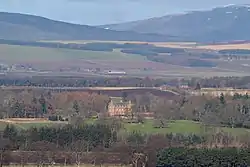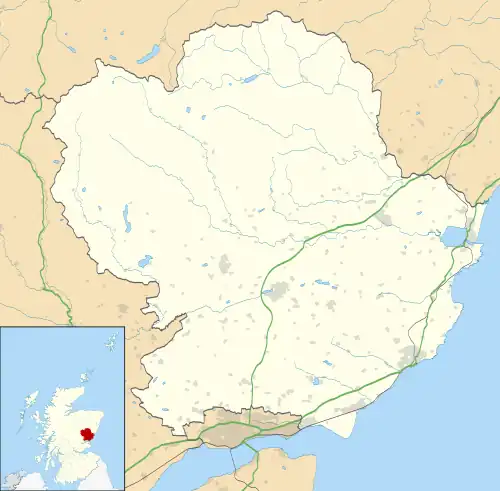Careston Castle
| Careston Castle | |
|---|---|
 Careston Castle from the south | |
 Careston Castle | |
| Coordinates | 56.725°N 2.75995°W |
| Site history | |
| Built | 16th century |
Careston Castle, also known as Caraldston Castle,[1] is an L-plan tower house dating from the 16th century, on a 1,528-acre estate,[2][3] in Careston parish, Angus, Scotland.[1]
It is a category A listed building.[4]
History
The name is said to derive from Keraldus, dempster to the Earls of Angus at the start of the 13th century.[3][5]
Nothing remains of an earlier castle.[3] The castle was built about 1582 by Sir Henry Lindsay, who became Earl of Crawford in 1620.[3] It was later owned successively by Sir John Stewart of Grantully, by the Skenes, by a farmer, and in 1871 bought by John Adamson, a mill owner from Blairgowrie and son of a whaling ship owner from Dundee.[3]
The property was listed for sale in October 2021. At that time, a report stated that it had been owned by the Adamson family for 149 years.[6]
Structure
The L-plan tower originally had three vaulted rooms, linked by a corridor in the first floor, although one room now has had its vault removed.[3] There is a large scale-and-platt stair to the first floor, a turnpike stair in the south west jamb, and a private stair on the north.[3]
Careston Castle is notable for its chimney-pieces.[3] The one in the Hall has an enriched cornice, and an overmantel with the Royal Arms of Scotland.[3] There are fine chimney-pieces also in the dining-room, and the central and east bedrooms on the second floor.[3] These chimney-pieces are thought to be derived in form from designs in Jacques Androuet du Cerceau's Second livre (1561).[7] Campbell also argues that Careston incorporates two of du Cerceau's house designs in the formation of its elevation and plan.[8] Two wings of the building have been demolished.[3]
A report in late 2021 stated that the 15,700sq ft castle's principal accommodation consisted of "four fine reception rooms, a library, six main bedrooms and five bathrooms — laid out over the first and second floors". Much of the ground floor was being used for storage and the rooms on the third floor were unused.[9]
References
- "Careston Castle". Canmore. Retrieved 5 June 2013.
- "Careston Castle and its vast estate come up for sale for the first time in a century and a half, an astonishing place with arguably the finest fireplaces in Scotland". Country Life. Retrieved 4 September 2022.
- Lindsay, Maurice (1986) The Castles of Scotland. Constable. ISBN 0-09-473430-5 p.46
- "Careston Castle". British Listed Buildings. Retrieved 7 June 2013.
- "Land of the Lindsays" (PDF). Land of the Lindsays. Retrieved 6 June 2013.
- "Careston Castle and its vast estate come up for sale for the first time in a century and a half, an astonishing place with arguably the finest fireplaces in Scotland". Country Life. Retrieved 4 September 2022.
- I. Campbell, 'From du Cerceau to du Cerceau: Scottish Aristocratic Architectural Taste, c. 1570- c.1750' Architectural Heritage 26 (2015), pp. 58-60.
- I. Campbell, 'From du Cerceau to du Cerceau: Scottish Aristocratic Architectural Taste, c. 1570- c.1750' Architectural Heritage 26 (2015), p. 65.
- "Careston Castle and its vast estate come up for sale for the first time in a century and a half, an astonishing place with arguably the finest fireplaces in Scotland". Country Life. Retrieved 4 September 2022.